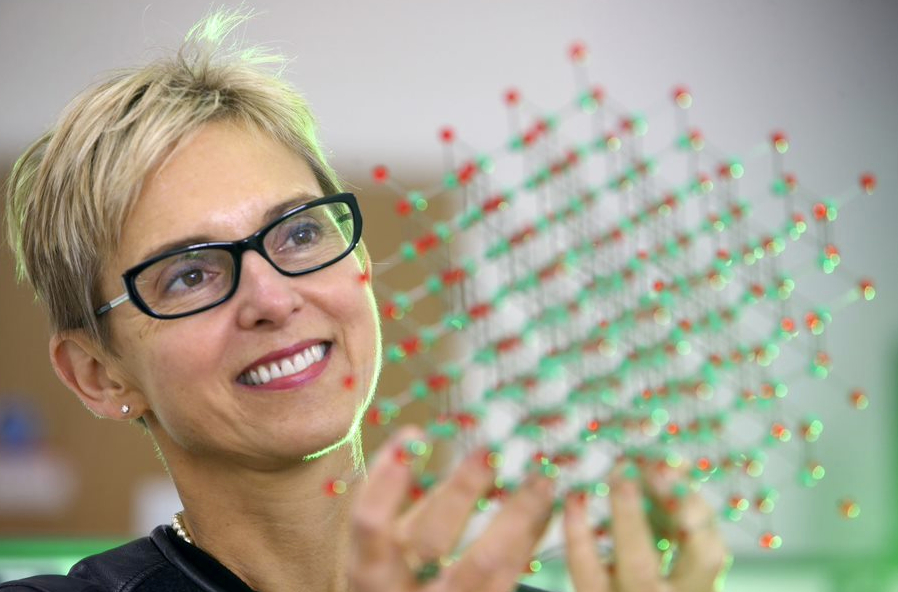Are these the lowest noise APDs?

AlAs0.56Sb0.44 lattice matched to InP could yield a new breed of high-performance receivers for networking and sensing, say Cardiff researchers
Fast, sensitive avalanche photodiodes (APDs) are required for high-speed datacomms and LIDAR systems. But the InP and InAlAs used as the gain material in these APDs have similar electron and hole impact ionisation coefficients (α and β, respectively) at high electric fields, giving rise to high excess noise and limiting their sensitivity and gain bandwidth product.
Now Cardiff University researchers led by Diana Huffaker, who is Sêr Cymru professor and scientific director of Institute for Compound Semiconductors (ICS), have reported extremely low excess noise in an AlAs0.56Sb0.44 lattice matched to InP technology.
They believe that their findings could yield a new breed of high-performance receivers for applications in networking and sensing. Their paper outlining the breakthrough is featured in Nature Photonics.
The ICS team worked on the measurements with Chee Hing Tan, director of the Advanced Detector Centre at the University of Sheffield and with Baolai Liang, technical director of the California NanoSystems Institute, University of California, Los Angeles (UCLA) who produced the epitaxial wafers. Their results, which showed a β/α ratio as low as 0.005 with an avalanche region of 1550 nm, are close to the theoretical minimum and significantly smaller than that of silicon. Further modelling suggested that vertically illuminated APDs with a sensitivity of −25.7 dBm at a bit error rate of 1 × 10−12at 25 Gb s−1 and 1550 nm could be realised.
Huffaker said: “Our work to develop extremely low excess noise and high sensitivity avalanche photodiodes has the potential to yield a new class of high-performance receivers for applications in networking and sensing.
“The innovation lies in the advanced materials development using MBE to grow the compound semiconductor crystal in an atom-by-atom regime. This particular material is rather complex and challenging to synthesise as it combines four different atoms requiring a new MBE methodology. The Sêr Cymru MBE facility is designed specifically to realise an entire family of challenging materials targeting future sensing solutions.”
Shiyu Xie, Sêr Cymru Cofund fellow said: “The results we are reporting are significant as they operate in very low-signal environment, at room temperature, and very importantly are compatible with the current InP optoelectronic platform used by most commercial communication vendors.
“These APDs have a wide range of applications. In LIDAR, or 3D laser mapping, they are used to produce high-resolution maps, with applications in geomorphology, seismology and in the control and navigation of some autonomous cars.
“Our findings can change the global field of research in APDs. The material we have developed can be a direct substitute in the current existing APDs, yielding a higher data transmission rate or enabling a much longer transmission distance.”
The Sêr Cymru Group within ICS is now preparing a proposal with collaborators at Sheffield for funding from UK Research and Innovation to support further work.
Cardiff University Vice-Chancellor, Colin Riordan, added: “The work of professor Huffaker’s Sêr Cymru Group plays a vital role in supporting the ongoing success of the wider Compound Semiconductor cluster, CS Connected, which brings together industry and academic partners in South Wales to develop 21st Century technologies that create economic prosperity.”
Huffaker added: “Our research produces direct benefits for industry. We are working closely with Airbus and the Compound Semiconductor Applications Catapult to apply this technology to future free space optics communication system.”
'Extremely low excess noise and high sensitivity AlAs0.56Sb0.44 avalanche photodiodes' by Xin Yi et al; Nature Photonics 08 July 2019


































